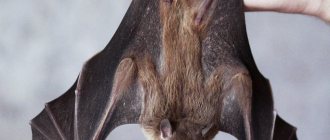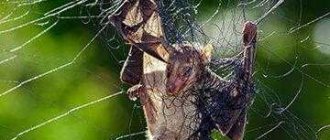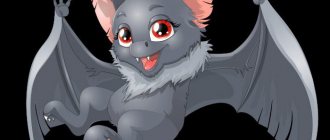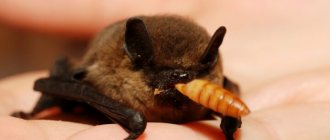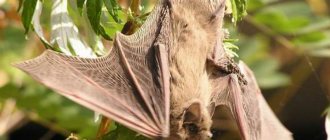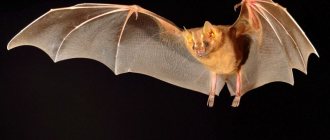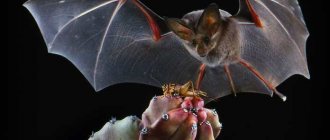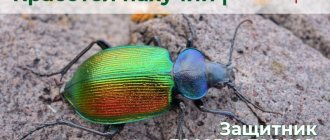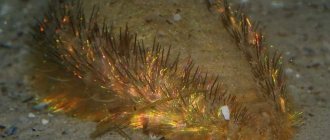In our latitudes, there are mainly bats that are small in size (up to 7 cm in height). Nevertheless, these animals are capable of instilling fear and horror in the person who encounters them. What if we imagine that the largest bat in the world is much larger? In general, what size can these animals reach? It turns out that there are real giants among bats in the world - giant golden flying foxes, which are representatives of the order Chiroptera and the family of fruit bats.
Variety of species
Chiropterans are divided into two large suborders:
- fruit bats;
- the bats.
In total, there are 1350 species of bats in the suborders. The main feature is the rapid flapping of its wings during flight. In an hour, a hunting mouse catches up to 200 mosquitoes. To catch insects in flight, you need to be light and fast, which explains the animals’ not very impressive size.
Fruit bats are much larger because they feed on tree fruits. The fruits do not require dexterity or speed from the hunter, but the weight of the animal still does not exceed 1 kg.
For most people, it is more common to call representatives of both suborders bats. So, when studying the question of which bat is ready to compete for the title of leader in the “Largest Bat in the World” rating, you should not discount the fruit bats either.
Natural enemies
Bats have practically no enemies, since no one deliberately hunts them.
But many large nocturnal birds are not averse to feasting on quick prey. Mice can also be eaten by snakes, weasels, ferrets or martens. But the damage to the population from natural enemies is so small that it is not taken into account by statistics.
The greatest harm to populations comes from destructive human activity. Every year, the areas suitable for mice to live in are shrinking. Many flyers die due to chemical treatment of fields, fires and deforestation.
Long-tongued bat
- Species name: Macroglossus sobrinus
- Weight: 18–26 g
- Color: brown-golden
In 10th place is the smallest of its frugivorous counterparts. The long-tongued mouse inhabits the mangrove swamps of Malaysia, but is also found in Thailand. Spends the night in tree branches alone and in groups.
View this post on Instagram
A post shared by Victor Ray (@v1cr4v)
Prefers to feed on the nectar of banana flowers. It was first described in 1911, but has been considered a full-fledged species since 1983.
Wahlberg's fruit bat with epaulets
- Species name: Epomophorus wahlbergi
- Weight: 54–125 g
- Color: brown-golden
The animal got its name because of the tufts of white fur located next to the ears around the scent glands. Males have tufts of white hair on their forearms. Wahlberg's mice use them during mating to attract the female's attention. The wingspan is 5–6 cm.
View this post on Instagram
A post shared by Victor Ray (@v1cr4v)
The fruit mouse lives in the forests of South Africa and feeds on the fruits of fruit trees. This allowed the animal to grow 2 times larger than the previous participant in the rating.
Offspring
Each year, the female of this species of animal can bear no more than one cub. She carries the future cub for six months. As a rule, cubs are born in the spring. As soon as the baby is born, the mother carries it with her for the first weeks. Then she leaves him alone on a branch, and only after that she returns to him to teach him to fly. It takes her a couple of months to create a new full-fledged member of the flock, who will fly along with everyone else and get food for herself.
Fijian monkey-faced bat
- Name: Mirimiri acrodonta
- Weight: 220–360 g
- Color: brown
As the name suggests, it lives exclusively in Fiji. This is the only mammal considered endemic to the island. It feeds on tough plant leaves and fruits.
View this post on Instagram
A post shared by Victor Ray (@v1cr4v)
Unlike other bats, it has not been studied enough. The reason is that the Fijian mouse is difficult to catch. The wingspan is 12 cm, the fur is thick, brown and red.
Virus carriers
In 2005, Eric Leroy of the International Center for Medical Research in Franceville discovered in Gabon that Egyptian flying dogs are natural carriers of the Ebola virus. In 2007, it was determined that Egyptian flying dogs are also natural carriers of the Marburg virus. The researchers found that in both cases the animals came from caves in Gabon and the Republic of Congo.
Video
- https://www.zoo-ekzo.ru/node/617https://usatiki.ru/letuchaya-sobaka/https://ru.wikipedia.org/wiki/Flying_dogshttps://ru.wikipedia.org/wiki/ Egyptian_flying_dog https://givotniymir.ru/letuchaya-sobaka-zhivotnoe-obraz-zhizni-i-sreda-obitaniya-letuchej-sobaki/
Flying Fox Lila
- Name: Pteropus lylei
- Weight: 250–300 g
- Color: black-brown with golden-red collar
The name was given to the species due to its similarity to a fox in the shape of its muzzle and red collar. Lives in Cambodia, Thailand, Vietnam. It is considered a very social animal, because it settles in colonies of 5,000 individuals.
View this post on Instagram
A post shared by Victor Ray (@v1cr4v)
The flying fox feeds on fruits. The fruit chews, spitting out the seeds, thereby helping forests grow in new territories. Can feed on nectar and flowers. Capable of covering 50–55 km in a day in search of food or a place to sleep at night.
Farmers believe that the flying fox is dangerous for gardens. Trees chosen by bats to establish a colony, after a while, remain without foliage and flowers. Therefore, local tribes exterminate mice and use them as food.
Nutrition
These creatures fly out to get food for themselves soon after dusk. They find something to profit from through their well-developed sense of smell and vision. The diet of night fruit bats is the most harmless. Its main part consists of fruits obtained from exotic southern trees.
Among them are bananas, dates, oranges, figs, mangoes. What else does a flying dog eat? She may also eat mushrooms, seeds, young leaves, or eat insects as food. Sometimes such creatures feast on flowers and nectar, and suck pollen, although they are not the main types of food.
Flying dogs love to eat fruit
Night fruit bats usually satisfy their hunger by hanging upside down on a tree. At the same time, they cling to a branch with one of the clawed llamas, and use the other to pluck fruits. But sometimes they are grabbed in passing, just flying by. They mainly satisfy the body's need for moisture by drinking fruit juice. But they also drink water. Moreover, sometimes they even use salted one. This is required by their special physiology.
Palm fruit bat
- Name: Eidolon helvum
- Weight: 250–340 g
- Color: brown
The palm fruit bat is called the straw-colored mouse because of the bright yellow collar around its neck. Yellow-brown stripes are visible on the back of the bat hunter. The fruit bat grows up to 14–23 cm in length. The wingspan is up to 76 cm. There are small claws at the ends of the wings.
View this post on Instagram
A post shared by Victor Ray (@v1cr4v)
Lives in Africa and the Arabian Peninsula. Settles in colonies of up to 100,000 individuals. Able to adapt to nutrition depending on the situation. In captivity, it feeds on food mixtures for rodents and pieces of juicy fruit. In the wild, it eats flowers, leaves, nectar, fruits and even tree bark.
Reproduction process
A fruit bat is considered sexually mature at the age of twelve months.
In some subspecies, the mating season begins in the spring, while others are ready to mate almost all year round. Flying dogs live in small harems of one male and three to five females.
Males are ready to mate around the clock. The process of intercourse usually takes place in the dark. With successful fertilization, pregnancy occurs, which lasts up to 110 days.
Childbirth takes place in a hanging position. The baby is born small, blind, but covered with thick hair, which contributes to good thermoregulation. At first, the babies do not leave their mother for a minute and even fly out with her to hunt, holding tightly to the female’s fur.
The baby is born small, blind, but covered with thick hair, which contributes to good thermoregulation.
For more than two months, little fruit bats feed exclusively on mother's milk. After this period, they gradually move away from their parents and join other families.
Under natural conditions, flying dogs live approximately 5-7 years; in captivity, this figure doubles.
Mariana flying fox
- Name: Pteropus mariannus
- Weight: 270–500 g
- Color: black-brown
The name was given to the species because of the characteristic fox-shaped skull. Around the neck the Mariana fox has yellowish fur. The length of the wings is 13–15 cm.
View this post on Instagram
A post shared by Victor Ray (@v1cr4v)
Lives in the Mariana Islands. It feeds on leaves and seeds. Among local peoples it is considered a culinary delicacy.
Comorian flying fox
- Name: Pteropus livingstonii
- Weight: 600–700 g
- Color: black with a golden tint
An honorable second place is occupied by the bat with a wingspan of 1.4–1.8 m. It, like other bats, was named for its resemblance to foxes. Breeds in the Comoros Islands.
View this post on Instagram
A post shared by Victor Ray (@v1cr4v)
It is difficult to chase insects weighing more than 0.5 kg - the Comorian flying fox prefers to glide. In flight, it catches the rising air current, relies on the strength of the wind and tries to flap its wings less often. Can look for insects and other food while sitting on a tree, but prefers to eat fruits.
Maned Acerodon
- Name: Acerodon jubatus
- Weight: 1.2–1.4 kg
- Color: reddish brown
The largest bat, that is, the fruit bat, in the world is the maned Acerodon. Because of the golden fur on the top of the head, the bat is called the giant golden-crowned flying fox. Another characteristic feature of the animal is its long wings, reaching a span of 1.5–1.7 m.
View this post on Instagram
A post shared by Victor Ray (@v1cr4v)
Acerodon lives in the mangroves of the Philippine archipelago. Active at night, sleeps on tree branches during the day.
Interesting facts about the animal
Interesting information from the life of giant noctules:
- the endurance of these mammals is amazing - they are able to easily fly over high mountains and overcome long distances;
- in flight, giant bats can reach speeds of up to 40 km/h;
- When communicating with each other, mice use sound signals inaccessible to human hearing;
- In some European countries, in particular Spain, close observation of these mammals and attempts to photograph them are prohibited.
The giant noctule is a rare species of bat that is on the verge of extinction. To stop this process, a person needs to explore the habitats of the noctule and its migration routes.
Old trees are of particular importance in the life of these mammals. Cutting them down for large bats means eviction from their homes. Preserving forests will help restore the number of giant bats.
The largest bat living in Russia
Only bats live in Russia. They are insectivorous and differ from fruit bats in the absence of a claw on the wing, a shortened muzzle and smaller size. Average weight: 4–10 g.
The three largest bats in the world are:
- great horseshoe bat;
- great harelip;
- giant nocturnal
Two of them are found in Russia.
Great horseshoe bat
The largest horseshoe mouse found in Europe is Rhinolophus ferrumequinum. Found throughout Eurasia. Settles in karst caves, in the attics of houses.
View this post on Instagram
A post shared by Victor Ray (@v1cr4v)
Flies out to hunt after dark. Weighs 13–34 g, wingspan is 30–40 cm, body length is 6–7.1 cm.
Great harelip
In every big company there must be someone who is “different from everyone else.” The great harelip (Noctilio leporinus) is one of these. It is the largest bat in South America.
View this post on Instagram
A post shared by Victor Ray (@v1cr4v)
Powerful wings allow the harelip to lift prey weighing 60–80 g. The winged hunter himself weighs the same. Sharp, curved claws help catch and hold prey. The object of the hunt is small fish.
Lifestyle and character traits
Almost all species are crepuscular or nocturnal. But in the natural environment there are species that can be active during the day.
Lifestyle
Some species of bats prefer a solitary lifestyle or gather in groups of 4–7 individuals.
But most species live in colonies and often combine with other species to form large settlements.
Females of the great bat gather in colonies of a thousand or more white individuals. It is noteworthy that there are practically no males in this group, as they prefer to stay alone. The largest colonies of bats are recorded in Brazil. Scientists managed to find a record number of individuals in one of the caves. Brazilian folded lips have gathered into a colony of 20 million individuals.
Bats prefer to sleep in a secluded shelter during the day. For their days, they choose caves, crevices, old hollows in trees, abandoned adits and quarries. Mice are not afraid of people and often live in barns, attics and other buildings.
Small species hide in cracks, climb under bird nests or under the bark of trees.
In some species, daytime shelters are located in rather original places. For example, in a spider's web or in an empty bamboo trunk. American suckerfoots shelter from sunlight in rolled banana leaves, and construction leaf-noses nibble on palm leaves to build a canopy.
Character and habits
Bats do not quarrel with each other and do not start fights for food and territory. Even different species can safely share one shelter.
During sleep and hibernation, mice hang upside down, clinging to any unevenness with their hind limbs.
Some species, such as night bats, when resting, wrap themselves in their wings and try to press closer to each other. Others, on the contrary, try to sleep away from their brothers.
Surprisingly, if during winter sleep a mouse falls from its place for some reason, it will simply freeze.
Although in wintering caves the temperature drops below zero, individuals hanging upside down calmly tolerate sub-zero temperatures.
Question to the expert
How do bats winter? Do they hibernate?
Only those mice that live in temperate latitudes hibernate. They gather in groups and press their bodies closely against each other. During winter sleep, metabolism and biological processes slow down so much that the fliers can be mistaken for dead. Some species do not hibernate, but migrate like birds to warmer climates. Tropical species do not hibernate and lead a normal lifestyle.
